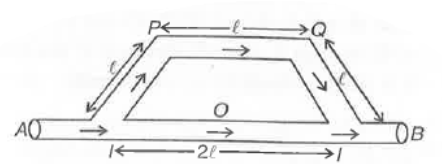Sound wave from a source A, follows two paths AOB and APQB in a tube as shown in figure. For silence at B, possible wavelength of sound will be
3l5
2l/5
5l/7
8l/3
Step by step video & image solution for Sound wave from a source A, follows two paths AOB and APQB in a tube as shown in figure. For silence at B, possible wavelength of sound will be by Physics experts to help you in doubts & scoring excellent marks in Class 12 exams.
Updated on:21/07/2023Topper's Solved these Questions
Similar Questions
A sound wave starting from source S, follows two paths AOBandACB to reach the detector D. If ABC is an equilateral traingle , of side l and there is silence at point D, the maximum wavelength (λ) of sound wave must be

View SolutionA sound wave starting from source S, follows two paths SEFDandSEABFD. If AB=1,AE=BF=0.6l and wavelength of wave is λ=6m. If maximum sound is heard at D , then maximum value of length l is

View SolutionA sound source emits two sinusoidal sound waves, both of wavelength λ, along paths A and B as shown in figure.The sound travelling along path B is reflected from five surfaces as shown and then merges at point Q, producing minimum intensity at that point.The minimum value of d in terms of λ is :

View SolutionA person standing at a distance of 6 m from a source of sound receives sound wave in two ways, one directly from the source and other after reflection from a rigid boundary as shown in the figure. The maximum wavelength for which, the person will receive maximum sound intensity, is

View SolutionTwo sound waves, originating from the same source, travel along different paths in air and then meet at a point. If the source vibrates at a frequency of 1.0 kHz and one path is 83 cm longer than the other, what will be the nature of interference? The speed of sound in air is 332ms−1.
View Solution
A wall is moving with velocity u and a source of sound moves with velocity u2 in the same direction as shown in the figure. Assuming that the sound travels with velocity 10u, the ratio of incident sound wavelength on the wall to the reflected sound wavelength by the wall is equal to
View SolutionA source and an observer are situated on two perpendicular tracks as shown in the figure the observer is at rest and source is moving with a speed 50m/s the source emits sound waves of frequency 90Hz which travel in the medium with velocity 200m/s the frequency of sound heard by observer when the source crosses the origin is

View Solutionsound singal is sent through a compostie tube as shown in the figure. The radius of the semicrcular portion of the tube is r, speed of sound in air is v, the source of sound is capable of giving varied frequencies . If n is an integaer then frequnecy for maximum intensity is given by

View SolutionSpeed of sound wave is v. If a reflector moves towards a stationary source emitting waves of frequency f with speed u, the wavelength of reflected waves will be
View SolutionSound waves from a loudspeaker spread nearly uniformly in all directions if the wavelength of the sound is much larger than the diameter of the loudspeaker. (a) Calculate the frequency for which the wavelength of sound in air is ten times the diameter of the speaker if the diameter is 20 cm. (b) Sound is essentially transmitted in the forward direction if the wavelength is much shorter than the diameter of the speaker. Calculate the frequency at which the wavelength of the sound is one tenth of the diameter of the speaker described above. Take the speed of sound to be 340ms−1.
View Solution
